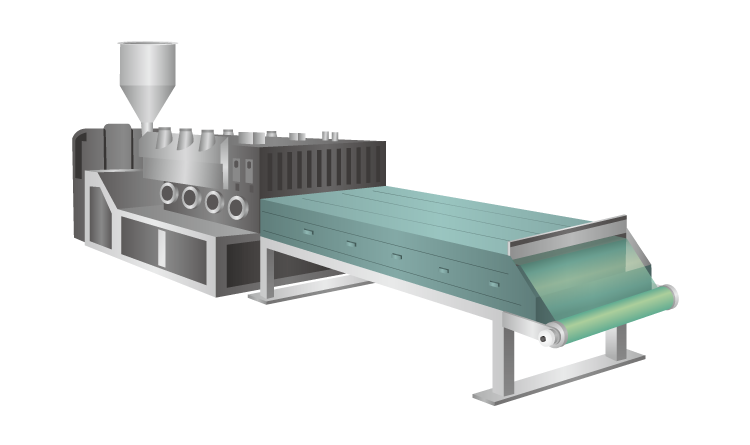Exhaust Gas Purification Catalysts (Metal Honeycomb Catalysts / Pellet Catalysts)

Exhaust Gas Purification Catalysts by TANAKA Precious Metals
TANAKA Kikinzoku Kogyo started manufacturing and selling exhaust gas purification catalysts in 1995.
It sells over a million liters of catalysts to customers at hundreds of various companies, which have used these catalysts over the long term.
Exhaust Gas Purification Catalyst Overview
Advantages of Introducing an Exhaust Gas Purification Catalyst


〇Global warming/climate change countermeasures
Volatile organic compounds (VOCs) with a high global warming potential are emitted as CO2 and H2O, which have low global warming potential. In addition, by decomposing and removing VOCs at a low temperature (approx. 350℃), much less fuel is required compared to exhaust gas purification using direct combustion such as with a burner (approx. 800℃). Running costs can be reduced while inhibiting the amount of CO2 produced with fuel combustion, thereby lowering the impact on the global environment.
〇Improvements in peripheral environment of plant etc.
Many VOCs cause strong odors or are poisonous even when only present in small trace amounts. Metal honeycomb catalysts, which enable high density cell design, are utilized to completely decompose these substances at low temperatures to improve working environments.
〇Compliance with VOC emission regulations
Various VOC emission regulations have been established in countries around the world with the aim of reducing amounts of VOCs, which are harmful to the environment. The application of metal honeycomb catalysts makes it possible to comply with various regulations based on preventing atmospheric pollution.
〇Reducing equipment size and costs
Better-performing catalysts enable equipment design with a smaller amount of catalysts at lower temperatures. As this can be applied to reducing equipment size and using universal materials, equipment costs can also be reduced. TKK metal honeycomb catalysts, produced by coating metal honeycomb having a large deployment area with high-performance catalysts, enable high catalyst performance with a small catalyst amount.
Features of Exhaust Gas Component Purification by Application Field
Catalyst Application Fields
Click each field to view information specific to that field.

Chemical Plant
Gas engine power generation system
Fuel cell power generation system
Enameled wire manufacturing equipment
Sterilization
Film manufacturing line
Catalyst Poisoning, Catalyst Degradation and Countermeasures
Click each blue link in the table to view characteristics and other data.
| Main types of poisoning and degradation | Mechanisms of poisoning and degradation | Effects | Examples | Countermeasures and our Support |
|---|---|---|---|---|
| Water vapor | Oxidative decomposition shifts to a slightly higher temperature depending on the decomposition gas (e.g. hydrogen or methane). While this depends on the concentration, there are hardly any degradation effects at saturated humidity or below. | Weak | ||
| Waste, dust Heat insulation material fragment Carbon |
Physically attaches to the catalyst surface. In small quantities, these substances would have little effect if they are removed. | Weak |   |
・Remove extraneous matter with air blowing or by washing with water ・Regularly pre-burn with the catalyst exit temperature at 600℃ or below |
| Tar | While carbon is the main component, it also contains S, Si or P compounds in many cases, and these can cause degradation. In large amounts, the catalyst might be blocked or a large amount of tar might be combusted all at once, causing dissolved loss of the catalyst. | Medium |  |
・Catalyst replacement (precious metal recovery) ・Regularly pre-burn with the catalyst exit temperature at 600℃ or below ・Investigation of regeneration processing |
| Sulfur compounds | Oxidation on the catalyst causes it to become SOx and sulfur components, causing degradation of the catalyst. Poisoning level differs depending on the decomposition gas components. At low concentrations, there is often little effect. Exhibits strong poisoning in methane combustion etc. At high concentrations, the honeycomb might undergo corrosion because of corrosive components. | Medium |  |
・Washing with water ・Application of sulfur poisoning durable catalyst ・Catalyst replacement (precious metal recovery) |
| Halogen compounds | Compounds such as fluorine, chlorine, bromine and iodine. These substances are absorbed to the active site and the reaction temperature shifts to a higher temperature. Inorganic acids such as hydrochloric acid are associated with corrosion etc., causing significant degradation. (Halogen poisoning test data example) |
Medium |  |
・Catalyst replacement (precious metal recovery) ・Pre-treatment catalyst installation ・Investigation of regeneration processing |
| Organic silicone compounds Organic phosphorus compounds Organometallic compounds |
These are typical substances that cause catalyst degradation. The formation of compounds such as SiO2 or P2O5 on the catalyst active site of Pt etc. covers the catalyst, thereby lowing its performance. (Silicone poisoning test data example) |
Strong |  |
・Catalyst replacement (precious metal recovery) ・Pre-treatment catalyst installation ・Investigation of regeneration processing ・Investigation of silicone countermeasure catalyst |
| Heat degradation | Exposure to high temperatures (600℃ or higher) causes small Pt particles to aggregate, lowering the number of active sites and causing catalyst degradation. Exposure to high temperatures of 1,000℃ or higher causes metal honeycomb deformation etc., which can lead to decreased performance due to cell blockage or the appearance of gaps. | Medium | ・Catalyst replacement (precious metal recovery) (Heat-resistant features of our catalysts) |
Exhaust Gas Purification Catalyst Product Support
We offer various types of technical support for catalysts. This includes offering test catalysts to confirm appropriate catalyst functioning before purchase, test catalyst assaying, on-site exhaust gas purification testing, confirmation of activity of catalysts in use, and factorial analysis in the case of degradation.
■Test catalyst installation and assaying

By installing various types of catalysts and then removing them after a certain period to confirm catalyst function, the most appropriate type of catalyst can be selected. Cutting-edge assaying equipment is also used to conduct various types of assays to test the state of the installed catalyst.
■On-site exhaust gas purification testing

Some exhaust gas is diverted and then tested after being blown through the catalyst to confirm actual gas purification performance in advance.
■Advice for catalyst installation

We offer advice on appropriately assembling catalysts on-site.
■Factorial survey of catalyst degradation

Analytical survey is conducted on catalyst activity and degradation factors when catalyst performance decreases.
There may be instances where we are unable to respond depending on the installation site of the catalyst or the particulars of the support. Please contact us for details.
Total Solutions by TANAKA Precious Metals
Catalyst Development (Precious Metal Catalysts)
A diverse range of precious metal raw materials, a full-range of research and development, manufacturing technologies and assaying and evaluation techniques are combined to develop exhaust gas purification catalysts specialized for precious metals, reforming catalysts, PROX catalysts and catalysts for the effective use of CO2, and various other types of catalysts that respond to customer needs.

Contract Production (Precious Metal Catalysts)
We aim to manufacture low-cost catalysts by combining the precious metal catalysts developed by our customers with our diverse precious metal raw materials and full range of catalyst manufacturing technologies.

We may not be able to respond depending on the specifics. Please contact us for details.
Recycling
Precious metals can be refined after being recovered from used precious metal catalysts using our advanced extraction techniques. The reuse of recovered and refined precious metals makes it possible to lower the costs of newly purchased catalysts.

